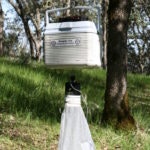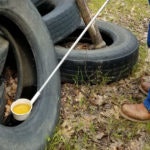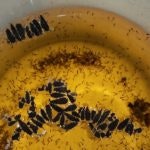Mosquitoes






Twenty-four mosquito species in six genera occur in Lake County. Each mosquito has its own preferred larval habitat, seasonality, and blood meal hosts. Mosquitoes undergo complete metamorphosis: egg, larvae, pupae, and adult. The first three of these stages are spent in the water.
Egg Stage
Depending on the species, mosquito eggs are laid singly or in rafts either on the water’s surface or on something solid that will eventually be under water. A female mosquito deposits 50 - 200 eggs. In the summer, the eggs can hatch into larvae in 2-3 days. Only unmoving water with organic material can support developing mosquito larvae, so females lay their eggs in tree holes that fill with rain water, tide water pools in salt marshes, sewage effluent ponds, irrigated pastures, rain water ponds, and horse troughs. Mosquitoes will also lay eggs in “backyard habitats” like unmaintained swimming pools and water features. Any container that holds water continually for a week may be a suitable habitat for a female to lay her eggs, even pet water dishes and overflow reservoirs beneath potted plants.
Larval Stage
Larvae grow through 4 instars or stages, shedding their hard outer skin each molt so the larvae can grow to the next stage. Larvae breathe air through a tube called a siphon that pokes through the water’s surface. They have a well-developed head with mouth brushes that filter algae, bacteria, and other microorganisms out of the water. The larval stage lasts between 4-14 days, depending on water temperature and mosquito species. After growing to a 4th instar, the larva transforms into a pupa.
Pupal Stage
The pupal stage for a mosquito is the equivalent of the cocoon stage for a butterfly; this is where the larval mosquito transforms into an adult mosquito. Pupae do not grow so they do not eat. They breathe through a pair of siphon tubes at the water surface, similar to the larvae. Once development is complete, the adult mosquito emerges from the pupal case.
Adult Stage
Three days after a female mosquito emerges from the pupal case she is ready to take a blood meal. It takes about three days, depending on temperature, for the blood meal to be digested and eggs to develop. Male mosquitoes do not take blood because they do not need to produce eggs. Because they need energy for flight and other activities, both male and female mosquitoes feed on plant nectar and other sugar sources. During summer, mosquitoes complete a full metamorphosis (from egg to adult), in approximately 7-10 days. If you add the approximately three days it takes for the female to harden and find a host and the three days it takes for eggs to develop, the time from egg-to-egg is approximately two weeks.
Mosquitoes of Lake County
| Scientific Name | Common Name |
|---|---|
| Aedes bicristatus | Snowpool mosquito |
| Aedes fitchii | Snowpool mosquito |
| Aedes increpitus | Snowpool mosquito |
| Aedes melanimon | Irrigated pasture mosquito |
| Aedes nigromaculis | Irrigated pasture mosquito |
| Aedes sierrensis | Western treehole mosquito |
| Aedes vexans | Inland floodwater mosquito |
| Anopheles franciscanus | No common name |
| Anopheles freeborni | Western malaria mosquito |
| Anopheles occidentalis | No common name |
| Anopheles punctipennis | Woodland malaria mosquito |
| Culex apicalis | No common name |
| Culex boharti | Bohart's mosquito |
| Culex erythrothorax | Tule mosquito |
| Culex pipiens | Northern house mosquito |
| Culex stigmatosoma | Banded foul water mosquito |
| Culex tarsalis | Western encephalitis mosquito |
| Culex territans | No common name |
| Culex thriambus | No common name |
| Culiseta incidens | Cool weather mosquito |
| Culiseta inornata | Large winter mosquito |
| Culiseta particeps | No common name |
| Orthopodomyia signifera | White-lined mosquito |
| Coquillettidia perturbans | Cattail mosquito |
Invasive Aedes mosquitoes
Three invasive mosquito species, Aedes aegypti (yellow fever mosquito), Aedes albopictus (Asian tiger mosquito), and Aedes notoscriptus (Australian backyard mosquito) have become established in California in recent years.
As of June 2025, no invasive Aedes mosquitoes have been detected in Lake County. The District’s surveillance program includes methods that specifically target these species.
These species share many similarities; they are:
- small, black-and-white mosquitoes
- bite aggressively during the day, especially in shaded areas of the yard
- lay eggs in containers (like buckets, roof gutters, used tires, wheelbarrows, children’s toys, canoes and other boats stored in yards, tarps, and other common backyard containers)
- have eggs that can remain dry for years and hatch when flooded
- can transmit Zika, dengue, chikungunya, West Nile, and other viruses.
More information about these invasive mosquitoes, including a map that shows their current range in California, is available from the California Department of Public Health’s Aedes aegypti (yellow fever mosquito) and Aedes albopictus (Asian tiger mosquito) page https://www.cdph.ca.gov/Programs/CID/DCDC/Pages/Aedes-aegypti-and-Aedes-albopictus-mosquitoes.aspx
